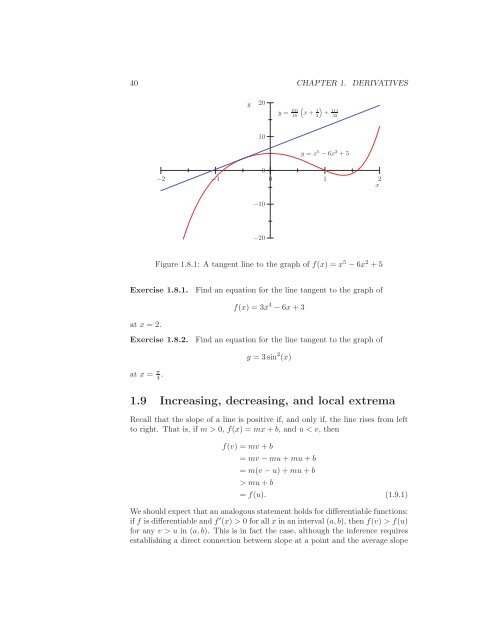Yet Another Calculus Text, 2007a
Yet Another Calculus Text, 2007a
Yet Another Calculus Text, 2007a
You also want an ePaper? Increase the reach of your titles
YUMPU automatically turns print PDFs into web optimized ePapers that Google loves.
40 CHAPTER 1. DERIVATIVES<br />
y<br />
20<br />
y = 101<br />
16<br />
( )<br />
x +<br />
1<br />
2 +<br />
111<br />
32<br />
10<br />
y = x 5 − 6x 2 +5<br />
0<br />
−2 −1 0 1 2<br />
x<br />
−10<br />
−20<br />
Figure 1.8.1: A tangent line to the graph of f(x) =x 5 − 6x 2 +5<br />
Exercise 1.8.1.<br />
Find an equation for the line tangent to the graph of<br />
f(x) =3x 4 − 6x +3<br />
at x =2.<br />
Exercise 1.8.2.<br />
Find an equation for the line tangent to the graph of<br />
y =3sin 2 (x)<br />
at x = π 4 .<br />
1.9 Increasing, decreasing, and local extrema<br />
Recall that the slope of a line is positive if, and only if, the line rises from left<br />
to right. That is, if m>0, f(x) =mx + b, andumu+ b<br />
= f(u). (1.9.1)<br />
We should expect that an analogous statement holds for differentiable functions:<br />
if f is differentiable and f ′ (x) > 0 for all x in an interval (a, b), then f(v) >f(u)<br />
for any v>uin (a, b). This is in fact the case, although the inference requires<br />
establishing a direct connection between slope at a point and the average slope


















